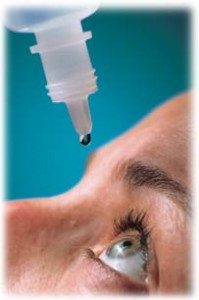Dry eyes and artificial tears
Dry eye syndrome is a condition that affects millions upon millions of people across the globe. The fact that it goes mostly undiagnosed and therefore untreated means that many people suffer discomfort and unknowingly risk permanent eye damage from this condition.
Tears are essential to the lubrication and nourishment of the eyes. The cornea, or front surface of the eye, has to be maintained in healthy condition to allow for clear vision. With each and every blink of our eyelids, tears are spread out over the cornea, washing away any particles of debris, provide lubrication, reduce chances of infection, as well as maintaining the clarity and smoothness of the surfaces. This eye-moistening process will lead to the production of excess tears in the eyes, which will usually drain into the area to the rear of the nose via minuscule drainage ducts that are located in the innermost corners of our eyes.
Artificial tear drops and ointments have been developed that effectively combat dry eye syndrome but unfortunately, a large percentage of the population goes without making use of them. Knowing the risk factors will allow you to safeguard our eyes from any permanent effects of dry eyes, while keeping you comfortable.
Causative factors of dry eye syndrome
The onset of dry eyes is caused either by an imbalance in the drainage and production rates of the tears or the production of tears that are of poor quality. Research into the condition indicate that it has ties to the following factors:
1. Gender – Dry eyes are made more likely by hormonal changes in women that come about as a result of menopause, pregnancy, and the ingestion of oral contraceptives.
2. Medical issues – Certain underlying medical conditions such as diabetes, thyroid problems, and rheumatoid arthritis increase the susceptibility of patients to dry eye syndrome. Blepharitis (inflammation of the eyelids), is a particularly notorious trigger of dry eye syndrome.
3. Age – As with so many other medical conditions humans are faced with, dry eye syndrome can as well be attributed to the degenerative effects of aging. It has even come to be considered in some quarters as a natural part of the aging process, with a large majority of those over the age of 65 experiencing some form of dry eye syndrome.
4. Environment – A person’s surroundings and lifestyle will at times contribute to drying out of the eyes. Windiness, smoke, and dry climate conditions, as well as a habit of unblinkingly staring at computer monitors for extended periods of time, will also contribute to the drying out of people’s eyes.
5. Medication – Interference with the operations of the lachrymal glands, which produce tears, has been attributed in many cases to the use of certain medications including decongestants, antidepressants, blood pressure medications, and antihistamines.

Managing dry eye syndrome with artificial tears
Artificial tears represent one of the most convenient and simple solutions to the dry eye problem. Because of the varying types, causes, and severities of dry eye syndrome patients may experience, no one artificial tear product is suitable for all.
Eye-drops broadly fall into two main categories – those that contain preservatives and those that are free of preservatives. The preservatives serve the purpose of inhibiting the growth and development of bacteria once the bottle is opened, although they may cause further irritation to eyes for those with severe or moderate dry eye syndrome. More generally recommended are the preservative free eye drops, more so if you are required to apply the artificial tears more than four times throughout the day.
Most times, patients will have to try different products before they find one that addresses their particular needs.

Comments are closed.